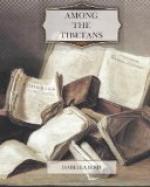We remained long on the blazing roof of the highest tower of the gonpo, while good Mr. Redslob disputed with the abbot ’concerning the things pertaining to the kingdom of God.’ The monks standing round laughed sneeringly. They had shown a little interest, Mr. R. said, on his earlier visits. The abbot accepted a copy of the Gospel of St. John. ‘St. Matthew,’ he observed, ‘is very laughable reading.’ Blasts of wild music and the braying of colossal horns honoured our departure, and our difficult descent to the apricot groves of Deskyid. On our return to Hundar the grain was ripe on Gergan’s fields. The first ripe ears were cut off, offered to the family divinity, and were then bound to the pillars of the house. In the comparatively fertile Nubra valley the wheat and barley are cut, not rooted up. While they cut the grain the men chant, ’May it increase, We will give to the poor, we will give to the lamas,’ with every stroke. They believe that it can be made to multiply both under the sickle and in the threshing, and perform many religious rites for its increase while it is in sheaves. After eight days the corn is trodden out by oxen on a threshing-floor renewed every year. After winnowing with wooden forks, they make the grain into a pyramid, insert a sacred symbol, and pile upon it the threshing instruments and sacks, erecting an axe on the apex with its blade turned to the west, as that is the quarter from which demons are supposed to come. In the afternoon they feast round it, always giving a portion to the axe, saying, ‘It is yours, it belongs not to me.’ At dusk they pour it into the sacks again, chanting, ‘May it increase.’ But these are not removed to the granary until late at night, at an hour when the hands of the demons are too much benumbed by the nightly frost to diminish the store. At the beginning of every one of these operations the presence of lamas is essential, to announce the auspicious moment, and conduct religious ceremonies. They receive fees, and are regaled with abundant chang and the fat of the land.
In Hundar, as elsewhere, we were made very welcome in all the houses. I have described the dwelling of Gergan. The poorer peasants occupy similar houses, but roughly built, and only two-storeyed, and the floors are merely clay. In them also the very numerous lower rooms are used for cattle and fodder only, while the upper part consists of an inner or winter room, an outer or supper room, a verandah room, and a family temple. Among their rude plenishings are large stone corn chests like sarcophagi, stone bowls from Baltistan, cauldrons, cooking pots, a tripod, wooden bowls, spoons, and dishes, earthen pots, and yaks’ and sheep’s packsaddles. The garments of the household are kept in long wooden boxes.




